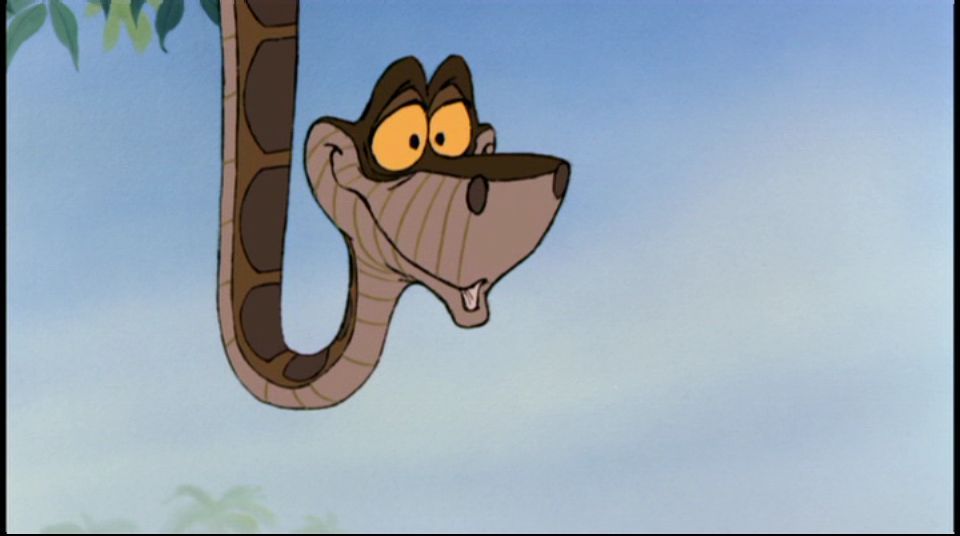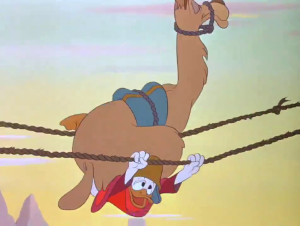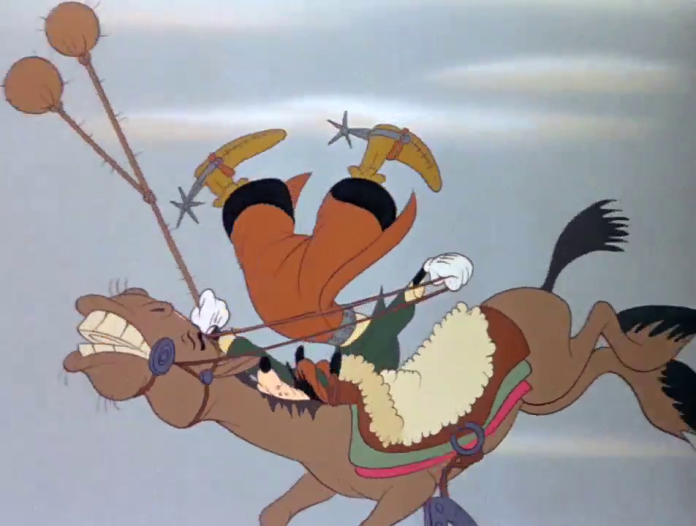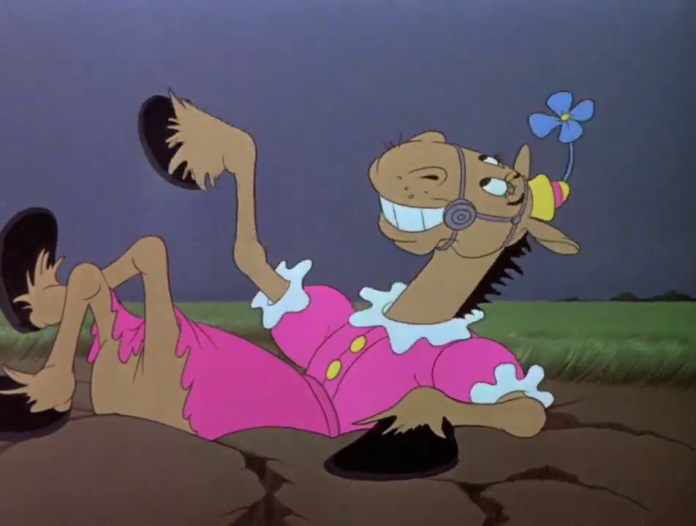Saludos Amigos (1942)
The Three Caballeros (1944)
James: So, we begin the package films. Saludos Amigos and The Three Caballeros were made with a few goals in mind:
1) Be cheaper than a full film (the reduced budget due to Disney’s previous losses, and fewer people and audiences due to the war effort)
2) Be informative (show the US more about Latin America, the government wanting better international relations, especially during wartime)
3) Give the animators an excuse for a paid holiday.
These being less important in retrospect (and features being more marketable than package films), Disney have never pushed these for re-release in the same way as they have other films, and so for both Anne and me this is our first experience coming to them.
And honestly, they’re pretty great. They’re fun, informative, innovative, with some enjoyable (if far less beautiful than Bambi or Pinocchio’s) animation and some very engaging music and songs. They’re also, at times, downright weird. But we’ll come to that in a bit.
Saludos Amigos, at only 42 minutes, is the shortest film we’ll review here. It’s composed of four animated shorts, connected by live action material of the artists seeing Latin America and learning about it, as we learn about it alongside them. There is no overarching story to this film, aside from the Disney animators experiencing new things and being inspired by them, culminating in each of the animated segments. The first segment shows us Donald Duck, himself a tourist in a strange land, learning about Lake Titicaca (and suffering a deal of slapstick while doing so). For the most part it’s fun if gentle, as the foreign ideas and ways are conveyed with comedy mostly pointed at Donald, carefully avoiding mocking the alien customs by mocking the American instead.
Anne: Oh right, because mocking the American is ALWAYS funny. Ahem.
I had such a good time watching Saludos Amigos–and not just because I was slightly tipsy from finishing off the open bottle of wine from my Rosh Hashanah party.

One of the things I liked best about this little movie was the live action photography of Latin and South America in the 1940s. I loved seeing footage of Buenos Aires and realizing that that’s what it looked like when the Perons were in power, and seeing natives of each location going about their daily business, 70 years ago. It was fascinating, and seeing the animators’ inspiration made each animated segment even more entertaining and interesting.
The second segment was silly and cute–about the Little Mail Plane That Could, called Pedro. We couldn’t help but wonder why he was wearing his mail bag on the outside.

The story of Pedro the Plane was a perfect opportunity (and really just an excuse) to showcase the mountains of Peru, especially the one that looks like a person.

Wonderfully atmospheric and scary, especially in the scene where little Pedro got his first glimpse of it and hid behind a cloud in fright.
I’m not doing a very good job of reviewing this segment, but it really was mostly scenery and silly plane antics, with mostly unnecessary narration (this was a theme throughout the two package films).
James: Indeed, it’s very much gone from the subtle implications of Bambi to overexplaining a lot throughout both films. On occasion, however, the narrator works with the piece as a character, such as in the third segment. He speaks to rather than through Goofy as he tries to be an Argentinian cowboy, or ‘gaucho’, and dictates and orders much of the action throughout, for humorous effect. This segment has a very strong focus on the funny and mostly succeeds, particularly the slow motion sequence where Goofy is riding his horse and chasing an ostrich. Yeah. Let that sink in.
I like that picture.
The whole segment culminates with Goofy having a (romantic?) dance with his horse and being narratively flown back to America, because… well, because that bit was over.
Anne: I guess that makes “El Gaucho Goofy” a dog-and-pony show.
I’ll be here all week.
Anyway, I get to talk about Jose Carioca! LOVE this character, he’s like a suave Latin Jiminy Cricket, or the Brazilian Maurice Chevalier in bird form–and what’s more, before we met him we got to see an animator drawing him. Incredibly charismatic and fun, plus he mostly speaks in Portuguese to the bewildered Donald Duck. Bravi to the folks at Disney for casting a Brazilian actor to voice a Brazilian character–what a concept. (Pet peeve of mine–I remember seeing Ratatouille and wondering why, in the name of authenticity, they couldn’t have hired French actors if they wanted French accents! But I’m getting ahead of myself by about 70 years.)

There’s a wonderfully charming moment when Donald Duck hands Jose Carioca his business card and Jose gets SO excited about meeting THE Donald Duck–el Pato Donald!–that he just talks and talks and talks in rapid-fire Portuguese while poor Donald tries to follow along in multiple dictionaries. Finally, Jose says, “Or, as you Americans would say, let’s go see the town!” (Donald is rightly shocked by this. It reminds me of the Quidditch World Cup in Harry Potter and the Goblet of Fire, when Cornelius Fudge has to sit next to the Bulgarian ambassador, who pretends he doesn’t speak English because it’s funnier that way.)
This segment is lovely all around. Jose Carioca teaches Donald about the samba, then they go out and dance and sing about how wonderful Brazil is. And that’s about it–until Three Caballeros when they get an extended segment about Bahìa and dance with Aurora Miranda (ANNE: “Is that Carmen Miranda?!”).
James: Jose Carioca is a delightful character, and it’s a shame he’s been all but forgotten in Disney history. His banter with Donald is delightful, and his whole attitude is just a pleasure whenever he’s on screen. And then, the movie ends, short but very sweet.
Saludos Amigos was successful enough to warrant a further trip to South America two years later. The Three Caballeros is much less obviously educational than its predecessor, and is much more gung ho with its attempts to entertain… with some success. The end result is a very, very weird film which mostly seems to know what it’s trying to do, and when it doesn’t it’s even more fascinating than when it does. There is a definite (if convoluted) plot line to the film, more so than even in previous features, following Donald Duck’s exploration of more parts of Latin America. It all takes place on his birthday, as he receives three gifts from Latin America (he won’t be so grateful when it gets to Latin America’s birthday and he has to buy 500 million presents).
First of all, he gets a projector with a video documentary about birds, which leads to our first two segments. The first is about Pablo the Penguin, who- wait, Pablo?
Anne: Right, Pablo is the penguin who can’t deal with living in the Arctic because it’s too cold. His best friend is a stove called Smoky Joe, and he dreams about relocating to Latin America. Why? “Well, that’s human nature for you, even if you’re a penguin.”
I thought this segment was funny and charming, but nearly ruined by Sterling Holloway’s narration. Sterling Holloway also voices this guy:

And this one:

It’s an excellent character voice, but there’s something odd and almost a little creepy about it here. Not to mention that the narration is just not necessary. It was even more overkill than Pablo the Plane’s narration; there was virtually nothing explained by the narrator that we couldn’t have figured out from watching the wordless cartoon, which was pretty well-plotted–even if Pablo’s longing to get to Latin America was more or less arbitrary. But rather less than more.
After Pablo is a short segment about all the different birds in Latin America…which somehow leads into a story about a flying donkey.
I mean, I’ve seen an elephant fly, but this is ridiculous!

In contrast to Pablo the Penguin, this section has narration that works FOR and WITH the animation rather than against it. The narrator is an old gaucho reminiscing about when he was a little gauchito; he’s not a reliable narrator, and as he remembers bits and pieces of the story, they appear on the screen. He interacts with his younger self as he tells the story, which makes for highly entertaining storytelling.
James: This bit is actually really fun. As you say, the interplay between the narrator and the story is a highlight, and the final sequence with the race is actually exciting (although I’m pretty sure flying is still cheating). This segment is also the first sign of just how weird Disney were prepared to get with this piece.
The weirdness continues in the main narrative as Donald’s next present is a book entitled ‘Brasil’, in the pages of which is our old friend Jose Carioca, who takes Donald into the book to explore the state of Baia. This segment begins strongly, but it does go on a bit, saying less about Baia as it goes on, and just indulging in the musical number. This would be fine, but the segment is 12 minutes long, and so no matter how fun it is it still feels drawn out. Still, there’s some fun stuff with the Aracuan bird…

…and some neat mixing in of live action.
Aurora Miranda, Carmen’s sister. Who knew?
After that we are introduced to our third Caballero, Panchito Pistoles!
Then Panchito, Jose and Donald sing the titular song. I can’t stress this enough, this is a fabulous song. Fun, exciting, imaginative… it’s like the Animaniacs theme tune. It just builds and builds with strongly defined characters and a fabulous sense of style. If you want a taste of the film, check this song out.
Anne: It doesn’t get much better than “We’re three happy chappies/ with snappy serapes!” Fantastic. I’m not being sarcastic. I love it.
Panchito, Jose and Donald head to Mexico on their magic serape…

…where horn dog Donald proceeds to chase every woman he sees. He dances with a character billed only as “Mexico Girl” on IMDB, and pursues a bevy of bathing beauties at the beach, making him a playa on the playa.
Ouch, I’m sorry. Strike that last remark.
All of the flirting and chasing does beg the question, where precisely was Daisy Duck at this point?

My research tells me that Daisy was created in 1940. So shame on you, Pato Donald. SHAME UPON THEE.
(It’s been a really long day and I’m getting slap-happy. Oh dear.)
Also, I have to say that I find both Panchito and Jose more interesting than Donald Duck. It’s too bad that they don’t appear much, if at all, beyond Saludos Amigos and Three Caballeros, because they’re both so charming and funny.
James: Maybe I was just conditioned the right way as a kid, but I do still love Donald Duck. He’s loveable and generally well meaning but also flawed, and more than anyone else this is his movie (although he’s arguably a secondary protagonist to Latin America). He’s not in too much of the film, but when he is he works with the characters around him, particularly Jose and Panchito, to be an enjoyable team player but still distinctly Donald. That said, it’d be great to see a return of the trio (according to Wikipedia they’ve recently been introduced to rides and parades at the various Disneyland resorts, so maybe we’ll see an animated reunion before long?).

And finally we reach the last segment… which is flipping MENTAL. Here’s the setup: Donald watches a video of an attractive woman(‘s face) singing a love song. He kisses the screen, and suddenly trips. I mean, really trips. Most of the last ten minutes is just Donald sliding through crazy animation with a loved up grin on his face. I really can’t describe this segment and get the true experience across to you, even just putting up individual images wouldn’t do justice to this insanity… so here it is in its entirety:
Skip through that, and you’ll see the kind of bizarre visuals I’m talking about. Honestly, I have no idea how I feel about this segment. The animation is fun, but it’s twice as long as Pink Elephants on Parade (which made a heck of a lot more sense). It’s not even really exploring Latin America anymore, aside from a few vaguely Mexican images like cacti and sombreros. It’s just… mad.
Still, at least it ends with a reprise of the titular song, and the three new friends enjoying some fireworks. The ending feels very abrupt, and the whole finale will likely leave you wondering what the heck you just witnessed. Maybe that’s a good thing?
Anne: Yeah, that bit went on a little too long for my taste. It’s too bad, because if it weren’t for that I would probably score Three Caballeros higher. To be honest, I’m finding it hard to score either of these films, because they were geared towards a specific purpose: to educate American audiences on Latin/South American culture, and to foster friendship and positive relationships. I think I’d give Saludos Amigos a 7/10, and Three Caballeros a 6.5/10–the former had the lion’s share of really good animated segments, but the latter had the fantastic “Three Caballeros” number, the flying donkey, and some gorgeous visuals in the Baìa section. It’s not so much that Saludos was BETTER, but Three Caballeros had a few segments that I found really detracted from my overall enjoyment. Subtracting points, here.
James: That’s where Saludos feels stronger because of its brevity, which is an unfortunate thing for it to come down to. Saludos just feels that bit too short for my tastes, not quite enough to get your teeth into… but Caballeros often doesn’t fill its time well enough. I think I’ll have to score both Saludos and Caballeros at 7, because while Caballeros has more flaws, it also has higher ambition in its animation, its character building and its exploration of Latin American culture. That said, they’re both fascinating and fun pieces, and they’ve introduced us to two wonderful new old characters.

Next up, Make Mine Music.






